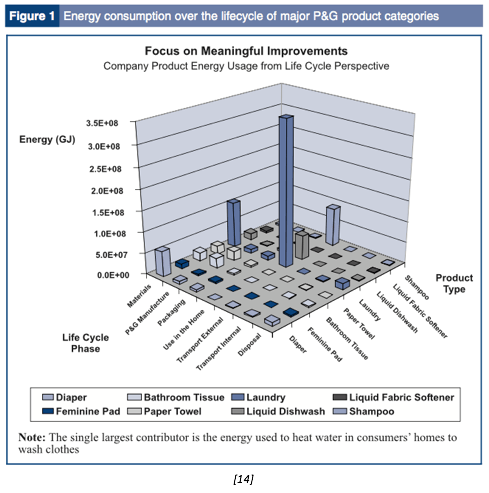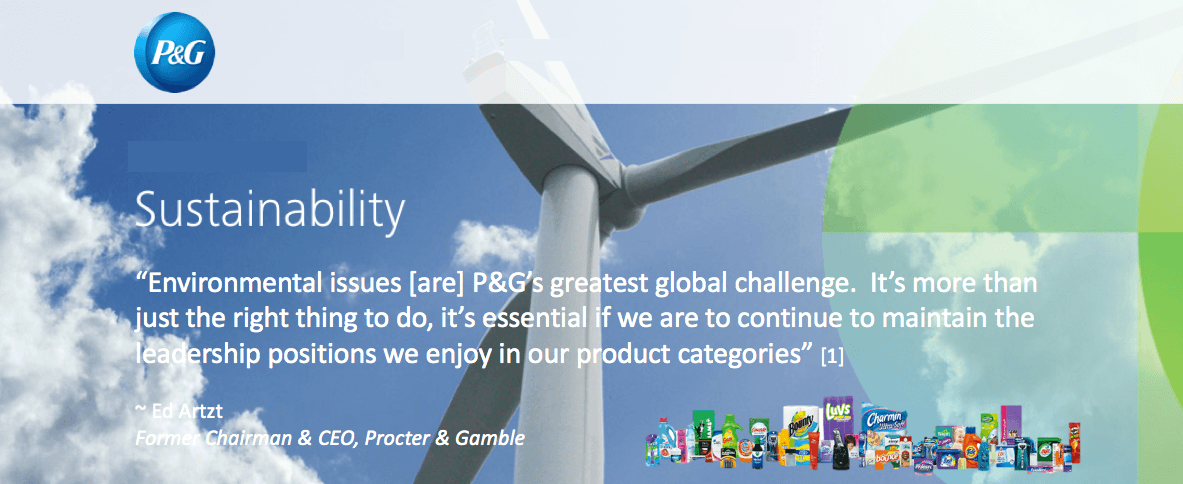Procter’s Environmental Gamble

P&G has made tremendous progress behind the scenes to introduce environmentally sustainable practices that reduce the effects of global warming – but if this progress isn’t commercialized and consumers aren’t aware, does it even matter?
If an environmental sustainability program falls in a forest and no one is around to hear it, does it make a sound?
Procter & Gamble, the world’s largest consumer packaged goods company touches and improves the lives of nearly 70 percent of the planet each day through its products. [2] The company has gone further than many competitors in reducing its carbon footprint. It has done so through improving manufacturing processes & reducing energy usage – but it has largely failed to communicate these improvements to its consumers either in the form of advertising or in the form of meaningful environmentally inspired products. As the general public becomes more conscious of climate change in its buying behavior, P&G faces the risk that consumers will deselect its brands if they do not understand and appreciate the lengths to which the company has gone to reduce greenhouse gases (GHG).
Ahead of its time and still pushing the boundaries of carbon emission reductions today
At current rates, greenhouse gasses are projected to more than triple from 404 ppm today to over 1,300 ppm in the next century [3], raising earth’s surface temperatures by up to as much as 14˚F [4,5] and wreaking havoc on the availability of livable land, supply of food and water, and accessibility of raw materials. Long before it was popular to do so, P&G published its first environmental safety publication in 1956. [6] More recently, the company has excelled in continuing to advance sustainability efforts behind the scenes. P&G has outlined a robust strategic plan, comprised of four primary goals to further reduce carbon emissions [7]:
- Reduce the absolute GHG emissions of operations by 30% by 2020
- Power all manufacturing plants with 100% renewable energy
- Use 100% renewable or recycled materials for all products and packaging
- Design products that delight consumers while maximizing the conservation of resources
Meaningful progress in manufacturing processes and energy usage has built strong momentum
P&G has realized significant progress in both manufacturing & supply chain. The company successfully converted 20% of transportation demand in North America from diesel operating fuel to natural gas. [8] In China, P&G built solar panels in the company’s Huangpu plant, resulting in a reduction of 600 metric tons of CO2 annually. [9] Similarly, the company opened its first 100% renewable powered wind plant in Jiangsu China, reducing 5,000 metric tons of CO2. [10] Through projects of this kind, P&G reduced its energy consumption by 46%, CO2 emissions by 52%, and water usage by 51% between 2002 and 2007. [11]
Despite meaningful improvement, consumer perception of environmental consciousness is largely unacknowledged due to lack of effective marketing
It is ironic that the world’s largest advertiser would suffer from brand image issues, but P&G has failed to successfully portray an environmentally conscious image to its consumers. Martin Riant, the company’s senior most Sustainability Leader recently said, “I don’t think we’ve done nearly enough with consumers in this area. Some of that flows from us not having the businesses as connected in the delivery of our sustainability goals as they need to be.” [12] This perception misalignment was highlighted in 2014 when nine Greenpeace activists broke into P&G’s global headquarters and hung banners criticizing the company’s lack of environmental policies, drawing significant negative media attention to the company.
The green path forward: bring consumers into the conversation and innovate with environmentally focused products
As climate change becomes increasingly salient, P&G must take a two pronged approach to effectively grow its environmentally responsible practices. First, the company should engage its consumers in a conversation to educate them about the largely unknown work it has been doing to improve manufacturing processes & supply chain.
 Secondly, the company should do more to reduce GHGs by designing dedicated products that will empower consumers to reduce the carbon footprint in their own homes. This is no simple task as fewer than 10% of consumers are willing to accept poorer performance or higher price for an environmentally improved product [13], but it is still possible to create win-win products that benefit consumers and environment alike. P&G has identified areas with the highest energy consumption (See Figure 1) and has begun to address these opportunities with products like Tide Cold Water, which enables consumers to wash their clothes in cold water with comparable efficacy to washing clothes in hot water, saving the substantial energy required to heat water.
Secondly, the company should do more to reduce GHGs by designing dedicated products that will empower consumers to reduce the carbon footprint in their own homes. This is no simple task as fewer than 10% of consumers are willing to accept poorer performance or higher price for an environmentally improved product [13], but it is still possible to create win-win products that benefit consumers and environment alike. P&G has identified areas with the highest energy consumption (See Figure 1) and has begun to address these opportunities with products like Tide Cold Water, which enables consumers to wash their clothes in cold water with comparable efficacy to washing clothes in hot water, saving the substantial energy required to heat water.
Continuing to innovate in these product areas will serve the dual purpose of bolstering P&G’s image and leadership in sustainable practices, and also continuing to further the impact to which the company can continue to lead the way in GHG emission reductions.
Word Count: 799 (excluding citations)
Sources
- Muller, E. J. “The quest for a quality environment.” Distribution1 (1992): 32-6.
- Makower, J. (2014, October 14). Why Procter & Gamble is resetting its sustainability goals. Retrieved November, from https://www.greenbiz.com/blog/2014/10/13/why-procter-gamble-resetting-its-sustainability-goals
- Summary for Policymakers, In: Climate Change 2014, Mitigation of Climate Change,” Intergovernmental Panel on Climate Change, 2014, p. 9, https://www.ipcc.ch/pdf/assessment-report/ar5/wg3/ipcc_wg3_ar5_summary-for-policymakers.pdf,accessed August 2016.
- Ibid
- 30 David Chandler, “Climate Change Odds Much Worse than Thought,” MIT News Office, May 19, 2009,http://newsoffice.mit.edu/2009/roulette-0519, accessed October 2014.
- Kumar, Ashish, et al. “Sustainable innitiatives taken by p&g to protect environment.” Recent Research in Science and Technology1 (2014).
- 2015 P&G Sustainability Report Executive Summary
- Kumar, Ashish, et al. “Sustainable innitiatives taken by p&g to protect environment.” Recent Research in Science and Technology1 (2014).
- Ibid
- Ibid
- White, Peter. “Building a sustainability strategy into the business.” Corporate Governance: The international journal of business in society4 (2009): 386-394.
- Makower, J. (2014, October 14). Why Procter & Gamble is resetting its sustainability goals. Retrieved November, from https://www.greenbiz.com/blog/2014/10/13/why-procter-gamble-resetting-its-sustainability-goals
- White, Peter. “Building a sustainability strategy into the business.” Corporate Governance: The international journal of business in society4 (2009): 386-394.
- Ibid




Stephen, I really enjoyed reading this post for the implicit question you raise: do corporations “do the right thing” simply because it is the right thing, or do they do it to not become a target of activists?
As consumers, we may make seemingly irrational decisions because the irrationality aligns with our personal views. For example, we might donate to a local charity because we believe that helping those less fortunate is the right thing to do, despite being able to spend the money on ourselves or invest it to grow in a savings account. As consumers, we do not have to justify these seemingly irrational actions.
Corporations, on the other hand, do have to justify “irrational” actions such as spending more on production to limit environmental impact. The tension arises because corporations are meant to generate profit for shareholders and costs for the climate’s sake cut into these profits.
Thus the question: Should corporations be seen more as individuals that “do the right thing” simply because it is the right thing? Or are corporations exempt from such expectations given their profit-based purpose? Corporations are between a rock and a hard place on this issue because they can suffer significant PR headwinds if they do not seek sustainability, but they may also have a harder time attracting capital if returns are insufficient for investors.
The question of whether and how a corporation should promote their sustainability efforts to consumers is an interesting one. I am slightly skeptical that consumers are being more environmentally conscious in their purchasing behavior, especially as it relates to everyday necessities and durables that are commoditized and in which price v. value typically drives purchasing behavior. I agree, however, that the key to promoting sustainability initiatives with consumers is to link them with consumer value, as in the case of Tide Cold Water. Outside of that, I think you run the risk of being perceived of greenwashing by consumers who are naturally skeptical of corporations seemingly “altruistic” practices, even if the initiatives have sounds business/bottom line impacts.
On the other side, related to investment, I do believe that including energy and sustainability metrics as part of materiality statements can be a positive signal that attracts capital. For instance, “investor interest in how companies are performing against different Environmental, Social, and Governance (ESG) metrics is growing. Today, more than $6.57T of capital takes ESG issues into account, and new research shows that companies focusing on material (not just any) sustainability metrics outperform the stock market by an average of 6%.” [1]
[1] http://www.energysmart.enernoc.com/a-crash-course-on-materiality-and-why-it-matters/
Thanks Stephen, for the great post! This ties in really well with our class discussion on IKEA, specifically around how they should set the company up for expansion in emerging markets where consumers may not have the same awareness around climate change and the ability to afford prices that absorb the negative externalities on the environment. P&G currently gets 39% of its sales in emerging markets. Unilever is at ~60%(1). Assuming that P&G will soon see similar proportions in sales as Unilever, how (if at all) do you think P&G should “bring consumers into the conversation and innovate with environmentally focused products” in the developing world? Given that CPGs are a competitive industry, if P&G cannot increase prices on their products in that part of the world, should they pass those costs onto consumers in the developed world, or absorb the costs on their own?
(1) http://www.wsj.com/articles/SB10001424052702304632204579340292194328288
Great post Stephen! Especially loved the unique aspect of P&G’s climate change problem that you have brought out. It is great to read about a company that starts their climate change initiative as early as 1956. This reaffirms the belief that P&G is sincere about its efforts against climate change and is not just putting up a front for media coverage.
Even after such efforts, I definitely agree with your viewpoint that P&G is failing at creating a customer perception of being an environmentally conscience company. Even recently it was accused of being a part of lobbying efforts against climate change regulations in EU [1]. I believe for an organization as big and far-reaching as P&G, they will constantly be under the scanner and therefore need to re-double their efforts to make sure customer correlate their brand with sustainability.
I do empathize with P&G for the hypocrisy of the customers. While they cry foul at P&G for not doing enough, they themselves are not ready to pay extra for environment friendly goods. One of their recent efforts to promote Forest Stewardship Council (FSC) and sell FSC-certified goods along with HP & Kimberley Clark might help inform the consumer about their environmental efforts. They were also a part of the White House climate change pledge [2]. Constant consumer awareness around such efforts will definitely help them keep up their efforts against climate change
[1] – http://www.sustainablebrands.com/press/sustainable_brands_corporate_members_engage_campaign_promote_fsc
[2] – http://fortune.com/2015/10/19/white-house-climate-pledge/